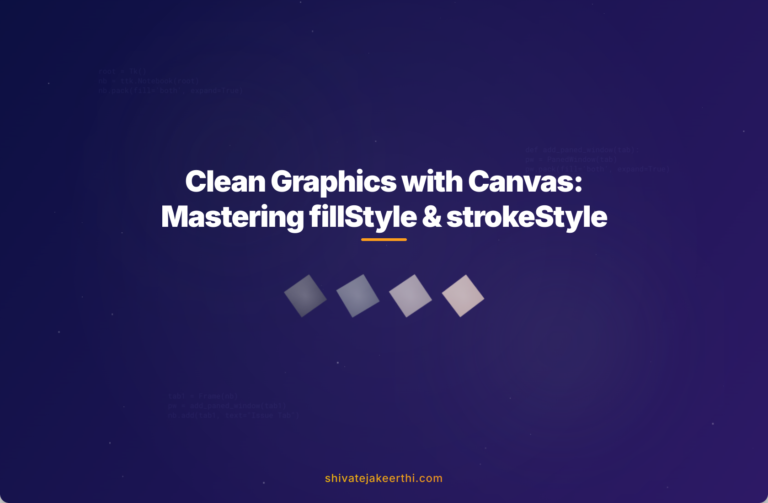When creating dynamic graphics with JavaScript Canvas, you may bump into situations where your latest fillStyle or strokeStyle settings unintentionally overwrite the colors or styles of previously drawn elements. This problem can be frustrating, especially when you’re working with multiple scripts or complex canvas operations.
Suppose your application includes several files like parkingplace.js, main.js, gates.js, and building.js, each drawing something on the canvas. It’s common to experience cases where changing color settings toward the end of a drawing cycle impacts earlier elements you already thought were set. This issue is common when you don’t manage your drawing state correctly.
Understanding Canvas Drawing
HTML Canvas is a powerful element that allows you to draw graphics directly in the browser using JavaScript. Imagine it as a painting canvas: every command you write instructs the browser what to draw and how.
When working with canvas, you usually start by grabbing the drawing context and then use methods and properties like fillRect(), strokeRect(), moveTo(), lineTo(), and arc() in combination with fillStyle and strokeStyle properties.
The fillStyle determines the color or pattern filling shapes, and strokeStyle handles the outlines. You can set solid colors, gradients, and even patterns, but these properties are global to your context, meaning that once changed, any following instructions without style resets will carry these settings forward.
Why Overwriting Happens in Canvas?
Overwriting usually occurs because the canvas context retains the last assigned styles. If you’re drawing a series of shapes without explicitly resetting your fillStyle and strokeStyle properties, each shape inherits the style set most recently.
Picture it as painting walls: if you change paint colors without thoroughly rinsing your brushes, the colors mix unintentionally. The same logic applies to canvas painting—styles linger until explicitly replaced.
Solutions for Overwriting Elements in Canvas
Fortunately, you can fix this style overwriting problem in several ways. Here are simple proven methods:
Using save(), restore(), and closePath()
Canvas gives you built-in methods like save() and restore() that can capture and restore the state of your context.
//Saving current state
ctx.save();
ctx.fillStyle = "blue";
ctx.fillRect(10, 10, 100, 50);
//Restoring previous state prevents overwriting
ctx.restore();
ctx.fillRect(10, 70, 100, 50); // This rectangle retains the original fillStyle
Using closePath() can also help clearly separate individual drawing segments, ensuring that styles applied after will not blend with previous elements unintentionally.
Creating Different Canvas Contexts
Another straightforward approach involves creating separate contexts. By layering multiple canvas elements on top of each other, each having its canvas context, you clearly isolate styles and draw independently.
This is like drawing on transparent sheets stacked in layers—each transparent sheet preserves its style separately.
Alternative Approaches
– Explicitly resetting fillStyle and strokeStyle before each drawing action.
– Structuring code carefully to avoid accidental overwrites by placing style declarations right before each draw command.
Often, explicitly applying these principles can resolve most overwriting hassles efficiently.
Analyzing Your Provided Code Files
Suppose you’re working with scripts such as parkingplace.js, main.js, gates.js, and building.js. To troubleshoot overwriting, carefully review each file:
- Identify every canvas context fillStyle and strokeStyle assignment.
- Check whether you reset these styles or use save() and restore() methods properly.
- Make sure your drawing operations occur logically without redundant style declarations.
Simplifying and cleaning each JS file helps narrow down exactly where overwriting issues originate.
Troubleshooting Canvas Drawing Issues
Canvas testing can feel tricky. Here’s how you can quickly debug:
- Use browser developer tools to inspect drawing processes in real-time (Recommended: Chrome DevTools).
- Insert console logs alongside style assignments and draw methods. This helps track style changes explicitly.
- Use breakpoints to step through your JavaScript and canvas operations.
Debugging canvas drawing issues in real-time offers invaluable insights and quickly highlights problematic code blocks.
Advanced Tips to Supercharge Canvas Graphics
Once your style overwriting issue is sorted out, consider enhancing canvas graphics further:
- Try gradients or patterns to add depth. Check MDN docs on createLinearGradient() and createPattern().
- Create animations or interactive canvas elements (this JavaScript guide has in-depth examples).
These techniques can dramatically improve the visual appeal and dynamism of your graphics.
Canvas Best Practices for Efficiency and Scalability
Good canvas graphics come from structured and maintainable code. Here’s how to keep canvas code clean and performant:
- Organize your workspace clearly, separating graphics logic from data handling and UI interactions.
- Group related drawing commands into reusable functions to eliminate repetitive code segments.
- Implement optimized drawing techniques like caching unchanged layers and minimizing redraws.
Doing these well ensures a smoother canvas experience, even as your application grows larger and more complex.
Recap & Final Bytes of Advice
We’ve seen that canvas fillStyle and strokeStyle overwriting issues commonly happen when developers don’t reset styles or use canvas state-saving procedures correctly. Understanding and wisely employing canvas state management methods like save() and restore(), or setting explicit style declarations clearly before each command, significantly improves your workflow.
Using separate contexts or canvases can further manage style separation clearly and efficiently. Adhering to best practices—such as structuring code logically, efficient debugging, and optimized graphics techniques—is key to creating reliable, beautiful JavaScript canvas projects.
If you’re still encountering canvas drawing troubles or looking to level up your JavaScript skills overall, check out helpful resources on Stack Overflow or explore more advanced tutorials right here on this site.
How have you resolved style overwriting in your own canvas projects? Share your tips or ask your questions below!



0 Comments